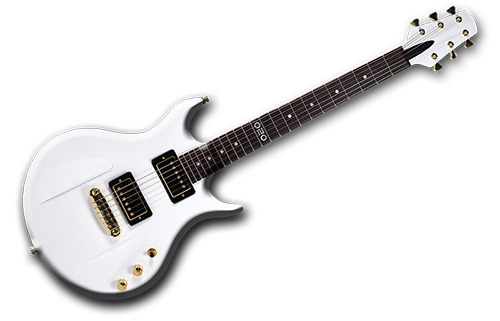Not well known in the US, Aristides Instruments of Haarlem, Netherlands, is manufacturing high-tech electric guitars and basses featuring a one-piece molded body made of an exclusive glass crystal in resin matrix (which they call “Arium”) with a glass/carbon skin. Their claim is that the material performs like a theoretically ideal wood analog. Since it has no grain, it is allowed to resonate equally in all directions of vibration. According to Aristides,
“The tonematerial is extremely hard and its unique cell structure is responsible for the unprecedented quality of sustain and resonance.”
I think I’d want to test this statement before purchasing an instrument. The fundamental physics of any stringed instrument determine that the energy of the vibrating string can is converted to acoustic energy. The more sound the resonant body produces, the more quickly the string’s vibrational energy is used up. The reason you can hear a harp or a piano over the sound of a symphony orchestra is that they convert a lot of string energy into acoustic energy very quickly. The mass of the string has a direct bearing on the initial energy available, which is why pianos use triple strung heavy wire under high tension in the high treble end.
The art of making any guitar is finding an ideal tradeoff between acoustic power and sustain. The more massive the instrument body, the more energy it takes to move it. So acoustic guitars are generally as light weight as they can be made considering other factors of structural integrity, the size needed for a resonant chamber, etc. The neck is relatively massive, for both structural and acoustic reasons. We want the string energy to go into the resonant sound box rather than into the non-resonant neck.
With electric guitars, the situation is very different. In this case we are usually going for a longer sustained sound of the plucked string. As well, guitar strings are relatively thin and low-tensioned as compared to a piano. Electric guitars are even sometimes fitted with extra-light strings to allow more ease in bending and rapid playing styles. So the initial energy provided is fairly weak. (An acoustic guitar is usually fitted with heavier strings to drive the soundboard.) The sound of an electric guitar comes from converting the string vibrations into an electrical signal which is then sent to an external amplifier and speaker. Since we don’t have to be so concerned about acoustic projection, we can instead design the body to add to sustaining the sound. This is why Les Paul and Leo Fender started out making electric guitars with massive, heavy solid bodies. The whole point of a solid body guitar is to conserve the energy of the vibrating string.
Now, having said that, there is, in fact, good reason to make an electric guitar with an acoustically resonating body. We aren’t concerned about projection, but rather about tone. And this is a much more arcane science. Much the way a fine wine has complexity of qualities–fruits, tannins, aromas, and changes as the flavors develop or break down in the mouth–the acoustic qualities of an instrument body add complexity to its tone. Wood has always been the preferred material for this purpose because it has the right combinations of strength, weight, and flexibility, while offering complexity in the ways it resonates with the string vibration at different fundamental frequencies and overtones. (As when a wine expert speaks of “high notes.”)
My instinct tells me that a synthetic guitar body will be more homogenous than a natural wood body, and thus would not provide that complexity. Or at least not by the material alone. It may be that the complexity is contrived more by the curves and cutouts of the synthetic body, rather than by the material alone. A block of spruce doesn’t vibrate very beautifully, but when carved into the shape of a violin belly, it is almost miraculous.
I have no doubt that the Aristides guitars are spectacular to play. If there was a dealer in the US anywhere nearby, I would certainly like to try one, since the claims are intriguing. Ultimately, sound preference is subjective. There are many factors affecting the sound of an electric guitar–the type, location, and quality of the pickups; the passive or active electronic components; and the types and settings of effects and amplifiers–altogether creating a gestalt that can be wonderful or awful. The material from which an instrument is made certainly affects the quality of the string energy being transmitted to the rest of the chain, but I would be wary of assuming that’s all there is to what makes a great guitar.
